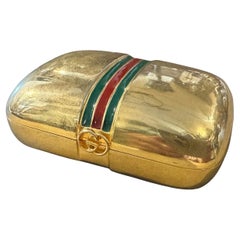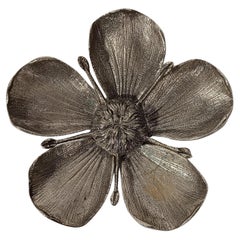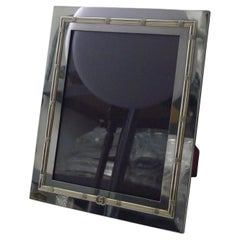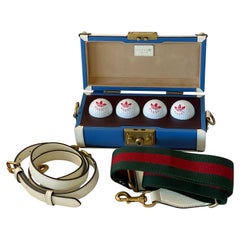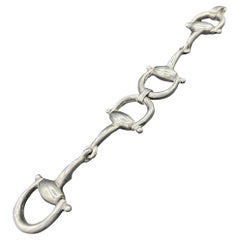Gucci Furniture
Long before trend-bucking creative director Alessandro Michele brought his hallucinatory “Utopian Fantasy” campaign to Gucci, it was a modest Italian leather shop. Today, it’s an internationally renowned luxury house with an iconic logo, and vintage Gucci clothing, handbags and shoes are among high fashion's most covetable goods.
Guccio Gucci (1881–1953) admired the stylish suitcases he saw wealthy guests arrive with at the Savoy Hotel in London, where he worked as a bellhop. So, in 1921, after a stint at Franzi, a luggage company in his hometown of Florence, he opened a leather goods shop of his own.
At first, Gucci’s Florence business specialized in equestrian accessories. But as its reputation flourished, particularly among the English aristocracy, so too did its footprint. In 1938, he brought three of his sons — Aldo, Vasco and Rodolfo — into the business and expanded it to Rome and later Milan. In the mid-1930s, a League of Nations embargo against Italy pushed Gucci to experiment with alternatives to imported leather. Its woven hemp fabric from Naples, adorned with the brand’s signature diamond print, was a hit, especially among A-list celebrities. The material was first used on suitcases before finding enduring popularity on handbags. (No list of revered designer purses would be complete without Gucci.)
In the 1950s, Elizabeth Taylor carried one of Gucci’s bamboo-handled tote bags, another adaptation to material rationing. After Jackie Kennedy was seen sporting a slouchy Gucci tote in 1961, it was renamed for the First Lady. Then Grace Kelly, on a visit to the boutique in Milan, inspired Rodolfo Gucci to work with Italian illustrator and Gucci textile designer Vittorio Accornero on the Flora print in 1966. Taking cues from Sandro Botticelli’s Primavera, with its pattern of flora and insects, it was painted entirely by hand and featured no fewer than 37 colors.
In 1953, just 15 days after opening his first store on New York’s 5th Avenue, Guccio passed away at 72. The early 1970s saw store openings in Tokyo and Hong Kong, but by the late 1980s, Gucci was floundering. Rodolfo Gucci took charge in 1982, but family drama and lawsuits ensued. In 1993, Rodolfo’s son, Maurizio, transferred his shares in the company to Investcorp, ending the family’s involvement in Gucci. Dawn Mello, then-president of Bergdorf Goodman, joined as creative director in 1989. But it was Tom Ford, who took over as creative director in 1994, who ultimately revived the brand.
Ford’s racy ads, shot by photographers such as Mario Testino, stirred controversy. And his potent vision of sexed-up femininity — with “jewel-toned satin shirts unbuttoned to there,” as Vogue described his breakthrough 1995 runway show — was wildly successful. The new millennium brought new ownership — Pinault Printemps Redoute in 2004 — and a more toned-down vision from Frida Giannini, who became sole creative director in 2006. Alessandro Michele was named creative director in 2015, and the storied brand took a giant leap forward.
Find vintage Gucci clothing and accessories on 1stDibs.
Late 20th Century Italian Modern Gucci Furniture
Brass
Mid-20th Century Italian Mid-Century Modern Gucci Furniture
Metal, Silver, Pewter
1970s Italian Mid-Century Modern Vintage Gucci Furniture
Silver Plate
1980s Italian Modern Vintage Gucci Furniture
Metal
21st Century and Contemporary Italian Gucci Furniture
Canvas, Wood
1960s Mid-Century Modern Vintage Gucci Furniture
Silver
21st Century and Contemporary Italian Gucci Furniture
Canvas
21st Century and Contemporary Italian Gucci Furniture
Canvas, Wood
1980s Italian Modern Vintage Gucci Furniture
Metal, Gold Plate, Enamel
1970s Italian Mid-Century Modern Vintage Gucci Furniture
Silver Plate
Late 20th Century Italian Mid-Century Modern Gucci Furniture
Silver Plate
20th Century Italian Gucci Furniture
Brass
1970s Italian Modern Vintage Gucci Furniture
Metal, Brass, Enamel, Chrome
20th Century Italian Gucci Furniture
Paper
1970s Italian Mid-Century Modern Vintage Gucci Furniture
Silver Plate
21st Century and Contemporary Italian Gucci Furniture
Porcelain
1970s Italian Vintage Gucci Furniture
Brass
21st Century and Contemporary Italian Gucci Furniture
Canvas
1980s Italian Vintage Gucci Furniture
Glass, Plastic
20th Century Italian Mid-Century Modern Gucci Furniture
Gold, Sterling Silver
1980s Italian Vintage Gucci Furniture
Metal, Gold Plate
1960s Italian Mid-Century Modern Vintage Gucci Furniture
Silver Plate
1970s Italian Mid-Century Modern Vintage Gucci Furniture
Brass
Mid-20th Century Italian Mid-Century Modern Gucci Furniture
Silver Plate
1970s Italian Modern Vintage Gucci Furniture
Brass
20th Century Italian Modern Gucci Furniture
Leather
1970s Italian Mid-Century Modern Vintage Gucci Furniture
Silver Plate
1960s Italian Modern Vintage Gucci Furniture
Brass
20th Century Italian Other Gucci Furniture
Leather, Fabric, Plastic, Paper
1970s Italian Hollywood Regency Vintage Gucci Furniture
Metal
1970s Italian Mid-Century Modern Vintage Gucci Furniture
Metal
1970s Italian Mid-Century Modern Vintage Gucci Furniture
Silver Plate
20th Century Italian Gucci Furniture
Porcelain
1970s Italian Hollywood Regency Vintage Gucci Furniture
Porcelain
1980s Italian Hollywood Regency Vintage Gucci Furniture
Ceramic, Leather, Suede
Mid-20th Century Italian Mid-Century Modern Gucci Furniture
Brass, Wrought Iron
Mid-20th Century Italian Gucci Furniture
Silver Plate
1970s Italian Mid-Century Modern Vintage Gucci Furniture
Metal
21st Century and Contemporary Italian Gucci Furniture
Porcelain
1970s Italian Vintage Gucci Furniture
Brass
Late 20th Century Italian Gucci Furniture
Leather
21st Century and Contemporary Portuguese Gucci Furniture
Porcelain
1960s Italian Mid-Century Modern Vintage Gucci Furniture
Silver
1970s Italian Modern Vintage Gucci Furniture
Gold Plate, Metal
2010s Danish Modern Gucci Furniture
Silk
Mid-20th Century Mid-Century Modern Gucci Furniture
Silver Plate, Brass
21st Century and Contemporary Italian Gucci Furniture
Glass
21st Century and Contemporary Italian Gucci Furniture
Metal
1980s Italian Vintage Gucci Furniture
Metal
1970s Italian Mid-Century Modern Vintage Gucci Furniture
Brass, Nickel, Gold Leaf
1970s Italian Modern Vintage Gucci Furniture
Brass
21st Century and Contemporary Italian Gucci Furniture
Canvas
1970s Italian Hollywood Regency Vintage Gucci Furniture
Metal
21st Century and Contemporary Italian Gucci Furniture
Porcelain
20th Century Italian Modern Gucci Furniture
Marble, Silver Plate, Bronze, Chrome
Late 20th Century Italian Modern Gucci Furniture
Porcelain
Late 20th Century Italian Mid-Century Modern Gucci Furniture
Canvas, PVC
21st Century and Contemporary Italian Gucci Furniture
Porcelain
1980s Italian Vintage Gucci Furniture
Brass
1970s Italian Vintage Gucci Furniture
Brass
Gucci furniture for sale on 1stDibs.
Creators Similar to Gucci
- 1stDibs ExpertApril 5, 2022Gucci Marmont is a collection of handbags crafted with matelassé leather. Matelassé is the stitching technique that gives Marmont bags their classic padded look. You’ll find a variety of Gucci Marmont bags from some of the world’s top sellers on 1stDibs.
- What is Gucci ophidia?1 Answer1stDibs ExpertApril 5, 2022Gucci Ophidia is a line of handbags from a collection that premiered in 2018. Primarily crafted from canvas, the iconic stripe and webbed design exudes vintage charm. You’ll find a variety of Gucci handbags from some of the world’s top sellers on 1stDibs.
- Are Gucci watches good?1 Answer1stDibs ExpertFebruary 22, 2021Gucci watches are more fashion than function, so if you want a super-stylish watch that simply tells time, a Gucci watch is great. However, if you're looking for a highly functional one, you may want to look at watch brands known for their functionality, such as Rolex.
- 1stDibs ExpertFebruary 22, 2021You can tell if a Gucci belt is real by looking at the sticker on the Gucci belt that contains a serial number and phrase “Made in Italy”. The serial number should be 21 digits long and will typically begin with the numbers 223 or 114. Many knockoff Gucci belts have serial numbers beginning with 1212.
- 1stDibs ExpertFebruary 22, 2021The best way to distinguish whether or not a Gucci purse is real is by looking for the serial number tag. These are typically located on the leather patch on the top of the inside. Find a variety of authentic Gucci handbags and purses on 1stDibs.Couture ClosetsMarch 21, 2021Stitching Should Be Even, Interior Tag Should Be Intact, Monogram Pattern Should Be Clear and Symmetric, Hardware Should Be Top Quality, Body Made From Premium Leather, Check Dustbag and Authenticity Cards, Logo Should Be Clear & Precise.
- What do I wear with Gucci mules?1 Answer1stDibs ExpertApril 5, 2022What to wear with Gucci mules really comes down to personal preference! Boasting an open back and a sleek design, you can dress Gucci mules up with tights or pair them with jeans for a laid-back look. On 1stDibs, find a collection of Gucci footwear from some of the world’s top sellers.
- Are Gucci shoes worth it?2 Answers1stDibs ExpertFebruary 22, 2021Gucci shoes are well-made using high-quality materials. As long as you're careful with them, Gucci shoes should last at least a few years through regular wear.Couture ClosetsMarch 23, 2021Simply, Yes. From fit, craftmanship, to quality of materials, to comfort level...A Gucci shoe lasts, period. If cared for, a Gucci shoe is sustainable, a "staple", timeless, always in style and donated or resold when you have moved on.
- 1stDibs ExpertMay 14, 2024Maurizio Gucci sold Gucci to Investcorp. Based in Bahrain, the organization is an investment fund that, at various times, has owned other luxury brands, including Tiffany & Co. In 1999, Kering purchased the majority share of Gucci. The French corporation has also owned Alexander McQueen, Balenciaga, Bottega Veneta and Yves Saint Laurent. Explore a collection of Gucci apparel and accessories on 1stDibs.
- 1stDibs ExpertMarch 13, 2024No, the Gucci family does not still own Gucci. Investcorp purchased the remaining shares of the Italian luxury fashion house owned by the family in 1993. Guccio Gucci originally founded the brand in 1921. On 1stDibs, find a diverse assortment of Gucci apparel and accessories from some of the world's top boutiques.
- 1stDibs ExpertAugust 15, 2024Yes, Paolo Gucci did design for Gucci. He took over the Italian luxury fashion house in the years following the death of his father, founder Guccio Gucci, in 1953. Paolo served as the chief designer for the maison during the 1960s. On 1stDibs, shop a large selection of Gucci apparel and accessories.
- What is a Gucci Rajah?1 Answer1stDibs ExpertApril 5, 2022The Gucci Rajah was a collection of bags released by Gucci in Fall/Winter 2018 and consisted of a sleek oversized tote bag and a shoulder bag. The design also featured a large roaring tiger head emblem. Find an assortment of Gucci bags from some of the world’s top sellers on 1stDibs.
- What is Gucci's style?1 Answer1stDibs ExpertMay 30, 2024Although Gucci's style has evolved over the years, many experts use words such as “bold” and “dramatic” to characterize its innovative designs. The Italian luxury fashion house is well known for its unique prints and vibrant color schemes. Gucci also often uses unexpected materials or combines materials together in imaginative ways. Many pieces feature embellishments, such as embroidery, beads and sequins. Find a large selection of Gucci bags and accessories on 1stDibs.
- What is Gucci famous for?1 Answer1stDibs ExpertMarch 13, 2024Gucci is perhaps most famous for its logo, a pair of interlocking Gs that pay tribute to founder Guccio Gucci. The motif appears on the buckles of the Italian luxury fashion house's belts, its jewelry pieces and its signature jacquard fabric. In addition, the logo features prominently on iconic Gucci bags, like the Marmont and the Ophidia. Find a variety of Gucci apparel and accessories on 1stDibs.
- Who designs Gucci?1 Answer1stDibs ExpertMarch 22, 2022At Gucci, the creative director primarily designs the fashions and accessories. Alessandro Michele took on the role of creative director for Gucci in 2015. Previous Gucci creative directors include founder Guccio Gucci, Tom Ford and Frida Giannini. Shop a curated collection of Gucci apparel on 1stDibs.
- Who were Gucci's designers?1 Answer1stDibs ExpertFebruary 1, 2024Many well-known names in fashion were once designers at Gucci. The original designer for the Italian luxury fashion house was Guccio Gucci. His sons Aldo, Vasco and Rodolfo began designing for Gucci during the 1940s, ’50s and ’60s. Other designers who have worked at Gucci include Tom Ford, Alessandra Facchinetti, Frida Giannini, Alessandro Michele and Sabato De Sarno. Shop a wide range of Gucci apparel and accessories on 1stDibs.
- Who resurrected Gucci?1 Answer1stDibs ExpertMay 30, 2024Tom Ford resurrected Gucci. By the late 1980s, the Italian fashion house was floundering, but that changed when Ford took over as creative director in 1994. His racy ads, shot by photographers such as Mario Testino, stirred controversy. And his potent vision of sexed-up femininity — with "jewel-toned satin shirts unbuttoned to there," as Vogue described his breakthrough 1995 runway show — was wildly successful. On 1stDibs, find a large selection of Gucci apparel and accessories.
- How do you pronounce Gucci?1 Answer1stDibs ExpertFebruary 20, 2024Gucci is pronounced GOO-chee. Gucci is an Italian name -- the renowned fashion house’s founder was Florence, Tuscany-born businessman Guccio Giovanbattista Giacinto Dario Maria Gucci. In the Italian language, the double "c" in Gucci is pronounced with the '"ch" sound that you hear in the beginning of words such as chime or chalk. Find vintage Gucci clothing and accessories on 1stDibs.
- Is Gucci for men?1 Answer1stDibs ExpertApril 5, 2022Yes, Gucci does have a men’s collection. High fashion knows no boundaries when it comes to eclectic contemporary pieces, and Gucci products represent the pinnacle of Italian craftsmanship. Shop an array of Gucci looks from some of the world’s top sellers on 1stDibs.
- Is Pucci the same as Gucci?1 Answer1stDibs ExpertJune 6, 2024No, Pucci is not the same as Gucci. Although their names are similar, the two brands are actually separate luxury fashion houses. Emilio Pucci founded his eponymous brand in 1947, while Guccio Gucci launched Gucci in 1921. On 1stDibs, shop a collection of Gucci and Pucci apparel and accessories.
- What is the history of Gucci?1 Answer1stDibs ExpertMarch 13, 2024The history of Gucci begins in 1921, when Guccio Gucci opened a leather goods shop in Florence, Italy. In 1938, he brought three of his sons (Aldo, Vasco and Rodolfo) into the business and expanded it to Rome and later Milan.
In the mid-1930s, a League of Nations embargo against Italy pushed Gucci to experiment with alternatives to imported leather. Its woven hemp fabric from Naples, adorned with the brand's signature diamond print, was a hit, especially among A-list celebrities. The use of bamboo for handles and locks originated after World War II, when leather and metal were in short supply. In 1947, the founder used the incredibly durable material for the first time in his Gucci Bamboo bag. In 1953, just 15 days after opening his first store on New York's 5th Avenue, Guccio passed away at 72.
The early 1970s saw store openings in Tokyo and Hong Kong, but by the late 1980s, Gucci was floundering. Rodolfo Gucci took charge in 1982, but family drama and lawsuits ensued. In 1993, Rodolfo's son, Maurizio, transferred his shares in the company to Investcorp, ending the family's involvement in Gucci. Dawn Mello, then-president of Bergdorf Goodman, joined as creative director in 1989. But it was Tom Ford, who took over as creative director in 1994, who ultimately revived the brand.
The new millennium brought new ownership and a more toned-down vision from Frida Giannini, who became sole creative director in 2006. Alessandro Michele was named creative director in 2015, and the storied brand took a giant leap forward. Michele exited Gucci in 2022 and was eventually replaced by Sabato De Sarno.
On 1stDibs, shop vintage Gucci bags, clothing and accessories. - Why is Gucci so popular?1 Answer1stDibs ExpertJanuary 4, 2022Gucci has always been one of the world’s most widely loved luxury brands. Its broad-reaching popularity today, however, owes largely to an upsurge of millennial interest in the company. Alessandro Michele was named creative director in 2015, and while this meant that the storied brand began to reflect an integration of popular culture’s influence and streetwear like never before, Gucci has always had a penchant for provocative and eccentric designs that shirk the status quo of fashion, a characteristic that has captivated its lifelong advocates and garnered a new legion of enthusiasts for the luxury house. Celebrities and influencers have further popularized the brand through social media, and pop stars have integrated Gucci in lyrics of hit songs. Find a range of vintage Gucci clothing and accessories on 1stDibs.
- What is the Gucci Marmont?1 Answer1stDibs ExpertMarch 31, 2023A Gucci Marmont is a collection of handbags made by the Italian luxury fashion house of Gucci. Inspired by the 1970s, the line includes details like quilted leather and chain straps and debuted in 2016. On 1stDibs, shop a collection of Gucci Marmont bags.
- Why is Gucci so expensive?2 Answers1stDibs ExpertFebruary 22, 2021Gucci is so expensive because it is a top-class designer brand which creates their products from quality raw materials and high production methods while employing some of the top talent in the fashion world. The brand's innovative designs along with its creative marketing strategy make Gucci a highly coveted brand.Couture ClosetsMarch 23, 2021The craftmanship, quality of materials and time spent on every item is extensive. Simply watch a video on YouTube of a Gucci handbag being handsewn and you will see what goes into every item. Gucci items last for generations and are often passed down, for this reason. A good quality, well made item, lasts for decades...That is sustainable, and better for all.
- What is a size 42 in Gucci?1 AnswerCouture ClosetsMarch 21, 2021Gucci size IT42 converts to a U.S. sized Medium or 6
- 1stDibs ExpertMarch 31, 2023What specific type of movement is on a Gucci watch varies. Generally, Gucci uses only high-quality Swiss quartz movements in all of their timepieces. On 1stDibs, find a range of Gucci watches.
- 1stDibs ExpertApril 5, 2022The Gucci Dionysus symbol is a tiger head. It relates to the fact that Greek myths say the god Dionysus rode across the Tigris River on the back of a tiger. On 1stDibs, find a large collection of Gucci apparel, bags and accessories.
- Are Gucci loafers a classic?1 Answer1stDibs ExpertFebruary 13, 2023Whether Gucci loafers are a classic is largely a matter of personal opinion. However, these shoes are comfortable and durable. They offer timeless appeal and have been available for purchase since 1953. Shop our Gucci collection featuring pieces from some of the world's top boutiques on 1stDibs.
Interiors Featuring Gucci
- Want to see more interiors?Browse more photos
